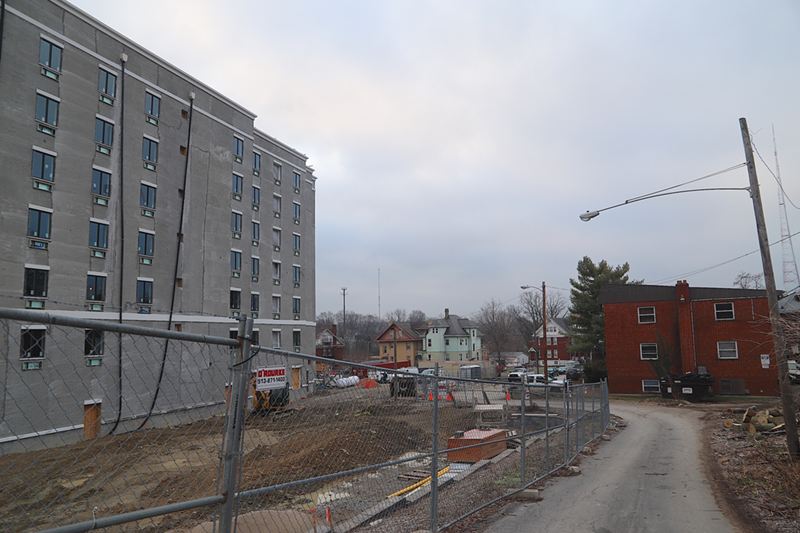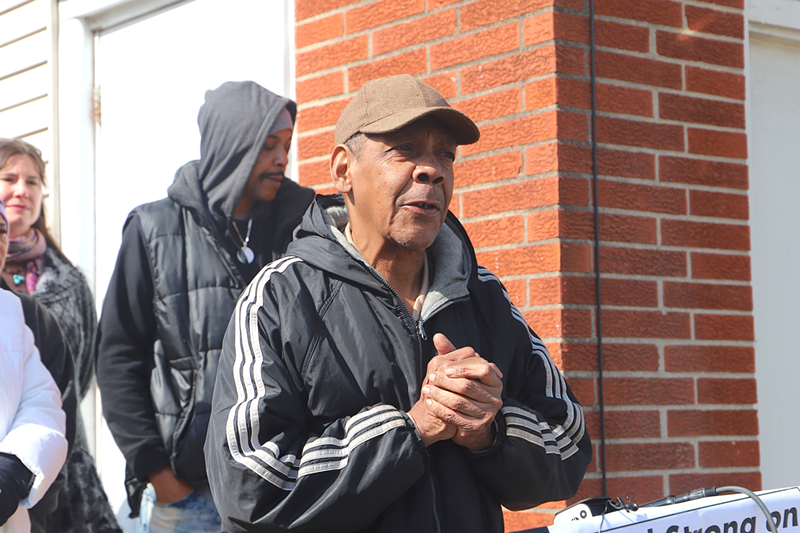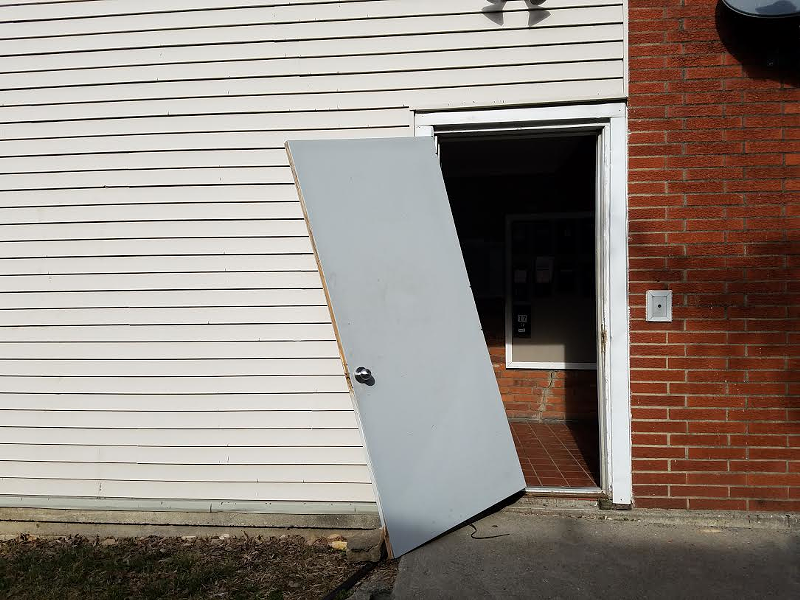
This story is the first in a series about housing insecurity in Greater Cincinnati.
When asked how long he has lived in his small basement apartment under the shadow of a coming Mount Auburn hotel, 66-year-old James Crawford produces an enormous brown accordion folder and begins pulling out pay stubs with the building’s address and his apartment number on them. 2000. 1999. 1998.
He’s looking for one from 1989, the year he says he moved into the building. By his count, he’s been here for 30 years. But in a few days, he will have to leave.
“I’m the oldest living tenant here,” Crawford says. “It was fantastic when I first moved in. Then things started going south in the community. It’s absolutely a good spot for me, though. Eden Park is right over here. It’s close to the bus line, I know people here. I’m working right down in Over-the-Rhine. Everyone wants to stay where they’re comfortable.
“Leaving here is like leaving a part of yourself behind. Everything must go — including me.”
LLCs affiliated with Kingsley + Co., the developers of the hotel across the street, purchased Crawford’s building and two others near the point where the road locals call “short Burnet” narrows into little more than an alley technically called Cumberland Street.
Crawford and several other residents CityBeat spoke with say they’re unsure what to do next. The 30-day notices to vacate the property they received at the end of December only list contact information for a property management company that residents say has not been responsive. Some residents say their leases were not expired when they received their notices.
Crawford is contemplating a stay in a shelter, if space is open in one, at least until an apartment that costs $500 a month or less opens up. Another resident who asked that his name not be used inquired about tent cities nearby he might stay in.
Kingsley founder and president Chinedum Ndukwe says the investors involved in the property want to turn the Burnet Avenue building into workforce housing — that is, units affordable to middle-income workers. He did not answer follow up questions about the details or the timeline for that planned redevelopment.
“We acquired the building in an ongoing effort to improve the available housing in Mt. Auburn,” Ndukwe wrote in a response to initial emailed questions. “My personal goal is to help provide safe and secure workforce housing in the building and other properties to combat the severe dearth of adequate, affordable housing in the area. Not one person was displaced in the building, and former tenants were provided the appropriate notice required by law that leases were not being renewed. For those facing challenges, there are non-profits that have capacity to help and are structured with resources for assistance.”
Workforce housing is generally priced for those making 80 to 120 percent of the area median income — about $40,000-$60,000 a year. That's significantly higher than the median income of the Census tract where the Burnet building is located and the current rents charged for apartments in that building, which range between $350 and $500 a month.
It is very challenging to build and maintain housing that rents for much less than that without hard-to-get subsidies, developers say.
The $14 million, 113-room hotel project received a 60-percent, 15-year tax abatement worth roughly $2 million approved by Cincinnati City Council in 2018. That abatement entered council via an unusual process — councilmembers Tamaya Dennard and Greg Landsman introduced it in the form of a motion. Usually, the city's Department of Community and Economic Development negotiates abatement deals, which council then approves.
Councilmember David Mann opposed the abatement process in that case, saying it wasn't proper procedure for council to make abatement deals.
Earlier that year, outgoing Cincinnati City Manager Harry Black released a memo in the midst of his tumultuous departure expressing ethical concerns about Kingsley + Co. lobbyist Jay Kincaid asking the city to sign a development deal with the company on a downtown property owned by the city. Kincaid was Mayor John Cranley's campaign manager at the time and had previously served as his chief of staff.
In exchange for the 2018 abatement, Kingsley has pledged to fund a youth wellness effort in the neighborhood, to hire locally when possible and to create at least 10 permanent jobs paying at least $15 an hour. Ndukwe says the hotel project will eventually create “130 direct and indirect jobs.”
Ndukwe has also stressed that Kingsley is minority owned and involved in other workforce housing efforts, including a project to the north in Avondale currently seeking state tax credits and city funding.
Workforce developments could help other middle-income renters in the future. But meanwhile residents in the Burnet property have faced a mad scramble for new places to live that are cheaper.
Michael Schiff’s Schiff Capital Group is an investor in the project at Burnet Avenue. He says he is willing to help residents of the building.
“We will never throw anyone out in the street,” he said in a voice message. “We’ll work with anyone who comes to us.”
Residents, meanwhile, say they weren’t even aware the Kingsley-affiliated LLC was the one who had purchased the building and say they haven’t had much luck contacting new ownership via the property manager listed on their notices— a company called Live Cincy.
In the building’s dim hallway, Crawford gives another resident named Clyde a copy of a list of places he has called in his search for housing. Down the list, next to each apartment, efficiency or “sleeping room” are handwritten notes — mostly the word “no.” One note reads “one year wait.” A couple of others say “call again” — not out of the question just yet, but dubious.
“Everyone is like, ‘We don’t have anything,’ ” Crawford says. “‘Nothing available. We’ll get back to you when have something.’ But I need something ASAP.”
One resident who is currently in the hospital did receive financial help from the new owners. Three others found housing via the building’s former owners, a company called Original Luster LLC that owns affordable and sober living housing in Cincinnati and Northern Kentucky. A few others found housing on their own.
About eight other residents including Crawford, however, are still looking.
The situation those residents find themselves in illustrates the complicated problems around housing affordability in Greater Cincinnati, especially in neighborhoods like Mount Auburn that have seen decades of disinvestment followed by a flow of new money into the community.
In addition to Kingsley’s coming hotel, real estate interest in the Census tract where the hotel and apartments in question are located has heated up.
Mount Auburn was once the city’s first luxurious hilltop suburb and is dominated by a number of grand, historic mansions. But the neighborhood suffered from white flight and general disinvestment starting in the 1960s and absorbed many African-American families as they left the part of the West End leveled by urban renewal and highway construction. Many of those big houses on the hill were subdivided up into apartments. As in many urban neighborhoods, property values — and often building conditions — deteriorated.
But as the neighborhood finds itself sandwiched between feverish redevelopment in hot spots like Over-the-Rhine, Walnut Hills and Uptown, things are beginning to change.
In 2013, just 13 mortgages worth less than $2 million were approved in the Census tract where Crawford lives, which stretches along Reading Road, McMillan Avenue, Auburn Avenue and Dorchester Street in the northeastern part of Mount Auburn. By 2018, those numbers had doubled — 27 loans worth almost $4 million, according to federal mortgage data.
Those loans went to applicants with a median income of $63,000, much higher than the neighborhood’s median income of $33,000. According to Census data cited by the city, 44 percent of the Census tract’s residents are in poverty.
Just down the road from the coming hotel, a house sold by its long-tenured residents for $42,000 in 2017 is now for sale for $210,000, and other houses nearby have gone for similar prices.
All that investment and interest in the neighborhood is a good sign, many say. But it also comes with downsides for some of its lower-income residents.
Just south of Crawford’s place, residents of two identical apartment buildings on Helen Street also purchased by Kingsley affiliates were given notice to leave over the summer.
One of those residents, a man named Jerry who asked that his last name not be used, had previously resided for years in a house a block away that had no running water and extensive water damage from a burst pipe. He was eventually told he had to move out two years ago.
The house’s owner sold it last year and it is now undergoing renovation.
Jerry, who has limited ability to work due to back injuries sustained after years of construction labor, struggled to find another affordable place to stay after he left the house. At the last minute, however, he secured a spot in the apartments on Helen Street.
That unit wasn’t ideal, but it was a step up, he says. Except it didn’t last long. After receiving his notice to vacate over summer, he’s now on Beekman Street in North Fairmount, miles away from Mount Auburn, where he lived for years.
Now some of his neighbors find themselves in a similar spot.
Original Luster sold the building on Burnet Avenue where Crawford lives in December after a group called Burnet Investments LLC approached them. That’s the group of investors affiliated with Kingsley and Company.
“Someone offered to buy the building, so we sold,” Original Luster representative Michelle Hart says.
Hart says Original Luster has tried to help out as much as it can, but has a limited number of units.
“As soon as we have new stuff on the board, we call the tenants we know are going to be displaced,” she says. “We had no idea they were going to be asked to leave.”
Hart acknowledges the market is tough for low-income renters. That’s borne out by research, including a well-publicized 2017 study by Greater Cincinnati Local Initiatives Support Corporation, which found that there is a 27,000-unit gap in housing for those making $25,000 a year or less.
“Our phone never stops,” Hart says. “There is a high demand for housing.”
The conditions in the building on Burnet Avenue are variable — and, sometimes, alarming.
During recent visits by a reporter, a side door to the building was off the hinges, allowing easy access to the building’s hallways, landings and laundry room.
Crawford’s unit suffered occasional flooding, he says, and a square cut from drywall above his sink to repair a pipe hasn’t been patched in many months. Upstairs, large patches of mold fringed the windows of another unit on the building’s west side.
Hart says the company stands behind the condition of the building at the time they sold it and that some tenants did not consent to the company’s biannual inspections.
She says the door to the building had been replaced multiple times after it had been torn off the hinges, something residents confirmed.
“I can’t tell you how many times we’ve replaced that door,” she says. “We tried every door you can think of.”
Both Original Luster and residents there agreed that the damage done to the doorway wasn’t caused by tenants but by others who do not live in the complex.
“They want to live there,” Hart says of residents. “They want a secure building. They aren’t doing this.”
A visualization of complaints to Cincinnati Police shows only minor crime reports in the past three years in the areas around the building.
Not all the units there are in bad shape.
Whitney Bowden lives — for the next day or two — in a unit on the east side of the building’s second floor. She says her oven has never worked, but her apartment is neat and clean, the walls a fresh white instead of the dim yellow-gray as seen in some other units.
Two friendly cats play on a climbing tree and plants hang out in various corners of the unit. Bowden sits on a mattress on the floor, surveying the last of her belongings still remaining in her soon-to-be former home. Most of it — the artwork she makes, her furniture and most of her clothing — is already out.
After receiving her 30-day notice, she began making time between her 10-hour shifts at her job at a manufacturing site to call around for new places. After several rounds of calls, Bowden ended up finding a somewhat more expensive apartment in Reading, outside the city limits.
She says the process was difficult.
“It was chaotic,” Bowden says. “Everything was short notice. They said they sold it and left us a number to call. It went to voicemail. I got the name of the (property management) company, Live Cincy. They left all these notes, but it was very hard to get in contact with a real person. I haven’t heard from them since January third.”
Calls by CityBeat to the number on the notice went to a full voicemail box and were not returned. Emails to an email address in the voice message bounced back.
It’s not the first move Bowden has undertaken recently. She moved into the Burnet Avenue building a year ago after rent on her former apartment in College Hill spiked by $200 a month over the course of a couple years.
“They started building it up over there and our rent went from $500 or $600 to $800,” she says. “My goal with moving this time is to try to stay out of the path of all that, so I just moved out of the city entirely.”







